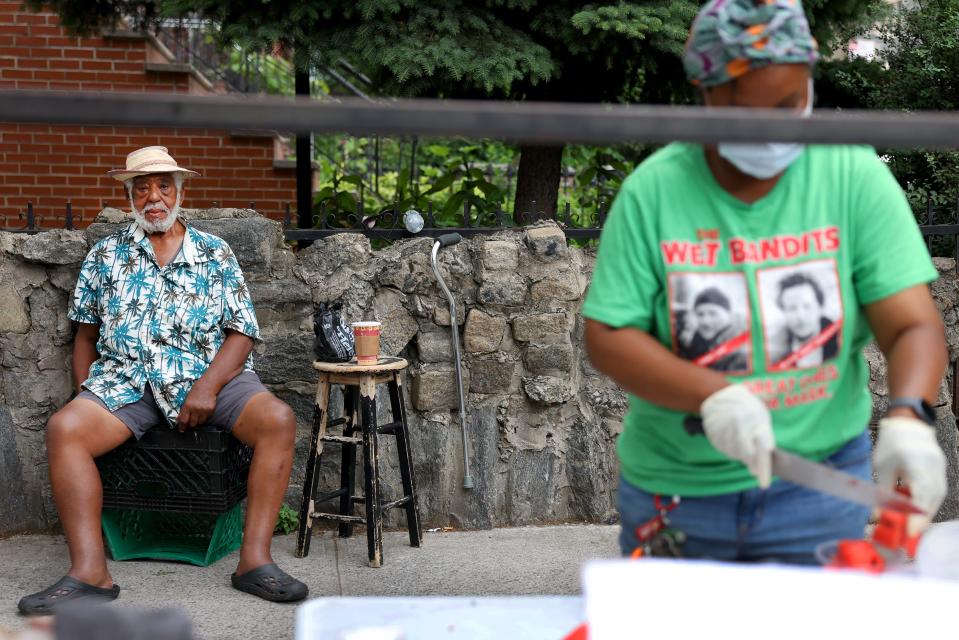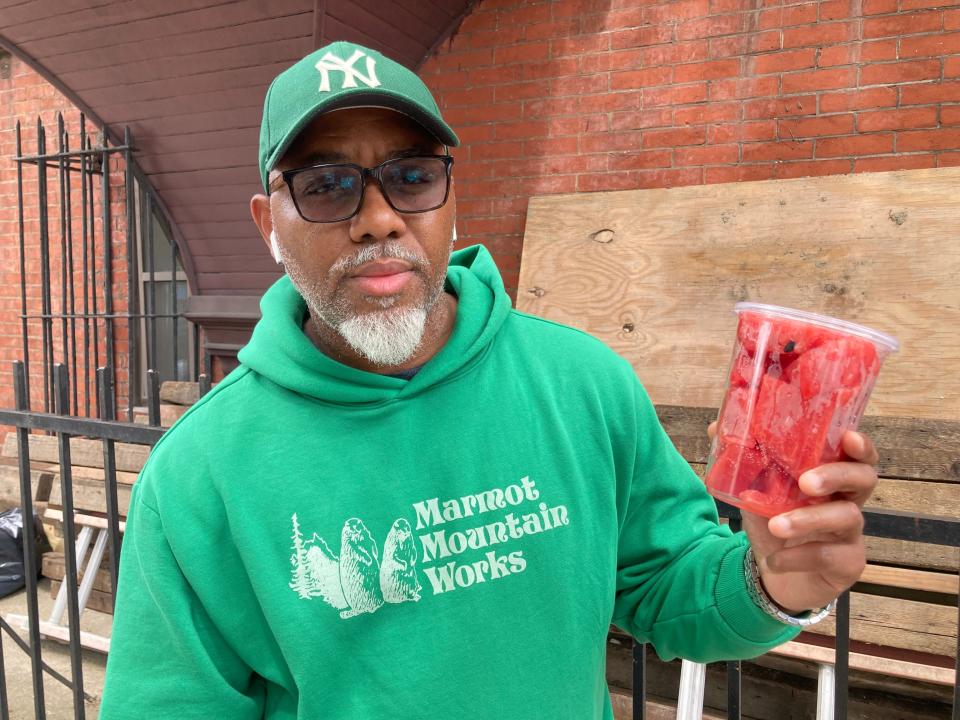In Bed-Stuy, a watermelon stand stands strong against tides of gentrification
NEW YORK − Every summer when the weather heats up in Bedford-Stuyvesant, a steady stream of residents descend on James Jackson's watermelon stand. They come on foot, on bicycles, on electric scooters and in cars and delivery trucks, blocking a central intersection to grab a cup of the sliced fruit.
Jackson's operation in the heart of Brooklyn has had a front-row seat to the seismic demographic shifts Bed-Stuy has faced since the 77-year-old began selling watermelon nearly 50 years ago. The massive neighborhood has gotten less Black, more white and some pillars of the community and networks of neighbors have been destroyed by gentrification.
Residents say Jackson is like a through line for the central Brooklyn community, selling his seeded melon every summer since he moved to Bed-Stuy from southern Virginia when he was in his 20s. Every fall, Jackson transitions to selling pumpkins and other seasonal gourds. In wintertime, he sells miniature Christmas trees.

“I feel good doing it, I enjoy meeting people coming by, speaking to them, making their day," Jackson told USA TODAY.
These days, there are more young white professionals who buy from Jackson and have personal relationships with him.
“He’s always out there, he’s always friendly, he always wants to help you out," said 32-year-old Caroline Ourso, a photographer who has lived in the neighborhood for seven years. “He encourages good community interaction because people stop and talk.”
Brooklyn A Black holiday predating Juneteenth was nearly lost to history, now it's back
Gentrification has made Bed-Stuy more white, less Black
Gentrification changes communities and neighborhoods racially and socioeconomically, said Greg Smithsimon, a sociology professor at nearby Brooklyn College, who teaches students how to document demographic shifts in New York City.
When a longtime low-income or working-class neighborhood starts to see signs of gentrification, Smithsimon said, people from outside the neighborhood move in and rent and home values increase. As a result, he said, people whose families have lived in the neighborhood for generations are more likely to be priced out.
"As you see very often in New York, developers identify properties they can buy and build big new apartment buildings where they're going to be charging rents that existing residents don't find affordable at all," Smithsimon said.
In Brooklyn's historic Bed-Stuy, beautiful blocks lined with historic brownstone townhouses and leafy trees soaring more than three stories high have been home to a thriving Black community for more than a century. The neighborhood was where Black civil rights activist Malcolm X lived in the 1960s before he was killed in 1965 at 39. Award-winning Black filmmaker Spike Lee lived in Bed-Stuy, and it's where his 1989 film "Do the Right Thing" is set. Acclaimed rapper The Notorious B.I.G. also grew up in the neighborhood in the 1980s.

Back then, Jackson and other neighbors felt like an extension of one's family, said Jason Roberts, a social worker who has lived in Bed-Stuy his whole life.
“This is a reflection of something that is kind of lost. The community is wavering to the times," Roberts, 52, said.

For about the past 15 years, a rapidly growing number of young white professionals have been drawn to Bed-Stuy because of cheaper rent, said Delano Burrowes, an activist and artist who fights for tenants' rights and racial justice in Brooklyn.
Bed-Stuy's Black population decreased from 75% in 2000 to 41% in 2022, the most recent year for which data is available. During that same time, the white population increased from just over 2% to over 29%, according to data from the Furman Center at New York University.
More white newcomers who earn higher incomes live in Bed-Stuy now compared to 2000, data shows.

The area's housing stock is attractive because it's been well-preserved by Black homeowners and "by Black power and economic development initiatives that started in the late ’60s," said Brian Purnell, a professor of African American history at Bowdoin College who wrote "Fighting Jim Crow in the County of Kings," a book on racial inequality in Brooklyn. Now, rich families who can afford to do so buy the historic brownstones for millions of dollars.
Housing problems aside, changing demographics don't have to be a wholly bad thing, and the process of gentrification doesn't have to erase and destroy community pillars, Burrowes said.
“If you’re coming into a place, understand what that community is about," Burrowes said. "You can be a gentrifier with some grace."
That's what Jackson's watermelon stand allows Bed-Stuy residents to do, said Richard Edmonds, a clerk at Brooklyn Hospital who has helped Jackson sell watermelon for nearly 20 years.
"As diverse as the neighborhood has become in the past 15 years, people still relate to him," Edmonds said.
But, still, the socioeconomic tension is palpable at times and falls along racial lines, both Smithsimon and Purnell said.
The neighborhood's median income has shot up, and rents have exploded, especially since 2010 through 2019 when it increased from from $49,440 to $73,840. The upward trend was even more pronounced among renters, whose median income increased by 65% during the same timeframe.
Data shows that in 2010 recent movers paid an average rent of $1,590 while, as of 2022, the average rent for newcomers in the area was $2,700.
"You have a neighborhood that looks like it might be getting integrated, but unfortunately, all too often you have two quite isolated communities in a place that's changing like that," Smithsimon said.

Watermelon stand holds community intact
"The history of this place is one in which the majority of Black people have struggled for stability and community," Purnell said. "If you have a demographic change on top of a place shaped by a history of racial underdevelopment then there's going to be disconnection. There's going to be distrust, there's going to be alienation," he said.
But, places like Jackson's watermelon stand can help combat that, according to Purnell.
"Moments where newcomers and longstanding residents can come together and create new relationships really matter because so much of the relationships in places like Bed-Stuy − through no fault of the residents themselves − are going to be made within the context of distrust and racialized underdevelopment," Purnell said.
Throughout Bed-Stuy, the white population has increased significantly since 2000, but white and Black residents often patronize different businesses and fail to interact with each other, he said. Schools in the area are also plagued by racial inequality, he added.
For Roberts, the social worker, Bed-Stuy has changed and some parts of the community may be lost forever, he said. But the watermelon stand is ensuring people still have a way to come together and look out for one another, he said.
"There was a time when your neighbor was like an additional parent," Roberts said. "This is a reflection of that."
This article originally appeared on USA TODAY: This Bed-Stuy watermelon stand is a sweet slice of community


